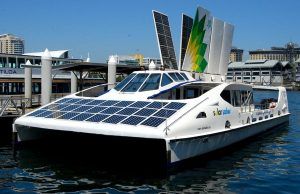Why Bill Gates and John Kerry are wrong about climate change
By John Carey | May 25, 2021
 Modern windmills. Image courtesy of Pexels/Pixabay
Modern windmills. Image courtesy of Pexels/Pixabay
There’s a recent phenomenon in which smart people, mostly white men, parachute down from a higher plane to tell us mere mortals the truth about fighting climate change. Colorfully dubbed “first-time climate dudes” by journalist Emily Atkin of the newsletter Heated, they invariably offer some version of doom and gloom, whether it’s Bill Gates calling any attempt to rapidly reduce greenhouse emissions to near zero “a fairy tale”, or novelist Jonathan Franzen proclaiming in the New Yorker that we must “accept that disaster is coming.”
Sorry, climate dudes, but I think you’re dead wrong.
Wrong too is John Kerry, President Joe Biden’s climate envoy, when he says that half of future emissions cuts will have to come from technologies not invented yet.
He should know better.
In fact, we already have the basic technologies we need to slay the monster of climate change. Moreover, these technologies are not just affordable now, but they continue to get cheaper (and better) at a stunning pace, and new ideas are constantly emerging. In fact, humanity may look back after 20 or 50 years and wonder why we ever thought it was so hard or so expensive to move beyond the era of fossil fuels.

Don’t misunderstand me, though. I can do alarmism as well as anyone—at least about the science. I wrote a story nine years ago about the growing worries and evidence that climate change could be happening faster than the consensus predictions at the time, as positive feedbacks like melting permafrost and declining sea ice coverage kicked in. Since then, it has become clear that the fears were more than justified. Without immediate and dramatic emissions reductions, we face an inevitable future of potentially catastrophic extreme weather—what an article in the journal Nature calls a “rapid and unstoppable” sea level rise, and many other devastating impacts. And if we delay too long, all those feedbacks could eventually push the planet towards a “hothouse Earth” scenario (as a scientific paper that went viral put it) like that of the Paleocene-Eocene Thermal Maximum 55 million years ago, when the Arctic was a subtropical paradise and the tropics may have been too hot for most life to exist.
But if both the threat and the need for urgent action are huge, the solutions are already at hand. While I’m not a professional scientist, I have covered climate change for BusinessWeek, Newsweek, and other publications for more than three decades and, in the last few years, have been fortunate to work as writer or editor on a number of reports on the topic, such as Risky Business’s From Risk to Return and both the Global Energy Transformation: A Roadmap to 2050 and Electrification with Renewables from the International Renewable Energy Agency (IRENA). These and a slew of other studies, like these 56 compiled by Stanford University, show a clearly achievable and affordable three-step path to making the dramatic emissions cuts needed to prevent climate catastrophe.
The first step: electrify everything possible. That means roads crawling with Teslas, Chevy Bolts (like mine), and their progeny; heat pumps and induction stoves in homes; electric furnaces in industry; and even electric ships and airplanes. Since using electricity is so much more efficient than burning fossil fuels, extensive electrification actually cuts total energy demand and energy costs—even at today’s prices for renewable energy. (And let’s not forget that the powertrain in an electric vehicle is light years more efficient than the one in the internal combustion engine of a gasoline-powered car; as little as 12 percent of the energy in the fuel is actually used to make a gasoline car move, while electric cars are 77 percent efficient or more—and electric powertrains have as few as 20 moving parts, while conventional power trains have 2,000.) And since most electrical devices can be quickly ramped up or down to match the electricity supply, and some, like plugged-in electric vehicles, can even pump electrons back into the grid, widespread electrification touches off a virtuous cycle. By making it easier to incorporate the variable output from wind turbines and solar arrays, it smooths the implementation of the second key step—generating all the electricity we need from renewables. The third step then is a serious expansion of energy efficiency measures like home weatherization to reduce overall energy consumption even further.
So why aren’t we racing down this path to a cleaner, safer future? In his recent book, The New Climate War, top climate scientist Michael Mann persuasively blames the powerful campaigns of denial, deception, distraction, and delay mounted by the fossil fuel industries and their supporters. But as he also hints, there is a more fundamental barrier that is rooted deep in human nature, which also helps explain the pernicious “doomism” of the “first-time climate dudes.” Basically, humans have always been lousy at foreseeing or even understanding the potential pace of technological and social change—or all of the new possibilities that can emerge from those advances.
Remember how IBM chairman Thomas Watson famously said in 1943 that there might be a total world market “for maybe five computers?” Or how Lord Kelvin predicted nearly half a century earlier that “radio has no future?” Or how no one dreamed that we’d all now be carrying the power of a 1990s supercomputer in our pockets, enabling us to buy virtually anything online, share cat videos, or binge-watch The Crown on Netflix?

Image courtesy of Manfred Antranias Zimmer/Pixabay
Failing to anticipate and take into account future innovation is a story that repeats itself over and over again, especially in areas like environmental and health regulation. For a story in BusinessWeek, I once dug up the actual costs of meeting new regulations that had been implemented years previously, such as limits on sulfur dioxide emissions imposed on power plants to curb acid rain. In every case, the final costs were far lower, and the reductions and benefits much greater, than even the most optimistic projections from the experts. The reason: Once rules or other types of incentives are in place, smart people will figure out clever new ways to get the job done.
That’s why Bill Gates is so wrong when he claims we need a technology “miracle” to successfully fight climate change. In fact, humanity has always been able to depend on something even more powerful than any single groundbreaking advance; we have a better magic in the form of innovation at all scales, from big breakthroughs to countless incremental improvements in materials, designs, manufacturing processes, and installation practices.
So it shouldn’t be a surprise that renewable technologies have declined in costs and been deployed faster that even the most optimistic projections. A 2012 US Energy Department publication reported that solar photovoltaic module prices had plunged from $4.90 per watt in 1998 to $1.28 per watt in 2011, dryly noting that “most analysts in recent history have underestimated the rapid reductions in module prices.” Indeed, the 2012 report itself was no exception to that persistent underestimation. It hoped that the Energy Department could spur a further 75 percent reduction by 2020. The actual drop? More than 85 percent, to under $0.2 per watt.
Similarly, just five years ago, Bloomberg New Energy Finance predicted that lithium-ion battery prices would drop to just under $200 per kilowatt-hour by 2020. That would represent a stunning decline from $1,000 per kilowatt-hour in 2010, but the estimate was not nearly ambitious enough. The actual lowest price in 2020 was $100 per kilowatt-hour.
And back in 2010, the International Energy Agency predicted that the world’s total capacity for solar PV (the “PV” stands for photovoltaics—the technology that converts incoming photons of sunlight to electricity) would hit 410 gigawatts by 2035.
Wrong.
By 2020, the number had already climbed past 707 gigawatts, IRENA reports. (To give a sense of scale with all these numbers, Hoover Dam generates 2 gigawatts.)
Because of these rapid advances, “new solar photovoltaic (PV) and onshore wind power cost less than keeping many existing coal plants in operation,” IRENA reports. Renewable capacity additions in 2020 hit an all-time record, up nearly 50 percent from 2019. And country after country is reporting record shares of renewable power on their electricity grids, such as the United Kingdom’s wind farms providing 48.5 percent of the nation’s entire electricity supply on a windy May 3, 2021, or Denmark generating more than 50 percent of its electricity from wind and solar for the entire year of 2020.
Now, every day brings new reports of potential advances. There are solar cells made with perovskite or stacked in 3D structures that may offer lower costs or higher efficiencies, and solar arrays built on hydropower reservoirs, thus making both types of generation more effective by cooling the panels and slowing evaporation from the reservoirs. Wind turbines continue to break records in size and output, such as an 855-foot-tall 15 megawatt behemoth from Vestas, and the pace of offshore wind development is accelerating rapidly to take advantage of a renewable resource so vast that it could supply 90 percent of the United States’ total electricity needs in 2050.
Nor are wind and solar the only renewable games in town. The horizontal drilling technology pioneered in fracking for gas and oil is now making it possible to create closed-loop geothermal energy systems that offer continuous low-cost baseload electricity—and a flexible source of power that can be readily “dispatched” (as the jargon goes) wherever it is needed to balance the second-by-second fluctuations in wind and solar generation. And powerful tides are fueling electric cars in Scotland and will be delivering megawatts to the Nova Scotia grid from the Bay of Fundy.

Meanwhile, the storage and use of electricity are being constantly improved. Consider lithium ion batteries laced with graphene to boost their energy density and extend lifetimes, solid state batteries that promise 50 percent greater energy density and more rapid charging, or demonstration projects that store renewable energy in hot stones. There also are innovative lighter and more powerful electric motors, like the inside-out design from Belgium start-up Magnax. (Typical motors have a stationary part—the stator—inside which there is a part that turns—the rotor. Magnax flips that around, with the rotor outside of the stator.) There are also standardized commercial geothermal heat pump systems that deliver heat and air conditioning at far higher efficiencies than competitors can. Even seemingly simple advances, like an ultra-reflective white paint, can cool buildings and bring major efficiency gains.
The key point here is not to single out any of these specific technologies or approaches as being magic bullets, but rather to highlight the fierce competition now underway that is already driving relentless, continual improvements and cost reductions in renewable energy technologies—and also potentially leading us down promising new avenues as yet unforeseen. We’ve already witnessed this competition in action in the demise of solar thermal systems (which used mirrors to reflect and concentrate the sun’s heat to heat up water), done in by ever-cheaper solar photovoltaic panels, and in the recent stumbles of would-be hydrogen-truck manufacturers, as improvements in lithium-ion batteries make electric trucks the better option.
And given the current pace of innovation, it’s possible to imagine a future far different from the despair and pessimism of the climate doomists. There’s no reason why we can’t be headed towards what solar energy pioneer Martin Green calls “a future of insanely cheap energy.”
So cheap, in fact, that some experts are already suggesting that one cost-effective way to create a reliable electricity grid with variable generation from wind and solar is simply to build massive overcapacity. The extra capacity, in turn, would then open up new possibilities, such as making enough “green” hydrogen or other renewable fuels and feedstocks (when electricity demand is lower than capacity) to eliminate greenhouse gas emissions from other activities that are hard to electrify, from steelmaking to ocean shipping. IRENA’s reports also document the potential for countries like Morocco or Chile to use their enormous solar resources to become profitable exporters of those renewable fuels.

Of course, none of this is easy. Nurturing the full flowering of these innovations and speeding their deployment will require immense political will, big investments, and a whole passel of supportive policies. But we should have the imagination and faith to understand that climate change is one problem that we can solve.
There’s no Gates-ian fairy tale, no Franzen-like acceptance of disaster, and no awaiting the invention of some Kerry-like miracle technologies.
As physicist Ray Pierrehumbert once wrote in these pages about renewable technology, “It is time to stop quivering in our boots in pointless fear of the future and just roll up our sleeves and build it.”
Together, we make the world safer.
The Bulletin elevates expert voices above the noise. But as an independent nonprofit organization, our operations depend on the support of readers like you. Help us continue to deliver quality journalism that holds leaders accountable. Your support of our work at any level is important. In return, we promise our coverage will be understandable, influential, vigilant, solution-oriented, and fair-minded. Together we can make a difference.
















This is a great article! We need to look at all the emerging technologies that are out there. My company is pioneering a small duel vertical axis wind turbine that is able to withstand Cat 5 Hurricanes and F5 Tornadoes, made with 100% recyclable materials and more compact and more efficient than anything out there right now. Combined with a couple solar panels and a hydride based solid state battery…and we have a self perpetuating micro grid that is scalable! The technology is here!
Why producing electrical power from high altitude wind didn’t succeed?
http://www.kitegen.com/en/
I would guess: maintenance cost & airspace utilization VS increased size/efficiency of static mount turbines.
(esp now we’re seeing 100m blades!)
The snark at the beginning of the piece diminishes the author’s position. It simply lacks professionalism.
Reactors. Lots of reactors.
All possible but you missed an important point. Without the alarms being raised we wouldn’t have seen this progress.
Why do writers, especialy white ones, always have to throw in “its usually white guys”. It ruins the whole article and draws attention to race issue rather than the point of the article. If he said “it’s usually black guys” there would be an organized riot somewhere for sure. Why is it so easy to condem all white people with no concern at all? I don’t see how it furthers any type of peaceful relations that we need so desperately right now.
My opinion is that the technology is here and workable. Also the computing power is here to model the effects. But I would have to agree with Bill Gates. I don’t think the governments have the will to act. A good example is the failure to eliminate nuclear weapons after 70 years, trillions of dollars and untold tons of high level radioactive waste unleashed. Of course one could make an argument the weapons have utility however modest but they also have great risk. A good source of information on where we stand on the climate timescale is Peter Wadhams. He… Read more »
John Kerry didn’t say “half of future emissions cuts will have to come from technologies not invented yet”. As the Guardian article linked to that misquote indicates in its title, he said the cuts “will come” i.e. a prediction not a prescription. The exact quote in the article reads “I am told by scientists that 50% of the reductions we have to make to get to net zero are going to come from technologies that we don’t yet have”. That seems perfectly consistent with the nearly homonymous author John Carey’s assertion that “every day brings new reports of potential advances.”
Almost everything discussed in this article is highly dependent on materials that come out of the ground. We will have to mine every metal that we can find, wherever we can find them.
you are talking nonsense mister. Tesla? Yes. But heating my house with electricity instead of gas would be very dumb. our electricity is renewable, comes from wood burning power-station. Wood is renewable, but pollutes like hell. Unlike my gas burning furnace. After all people cook with gas in unventilated houses. And the efficiency is incredible. I can’t have solar, too many trees. My gas bill is half of what people here pay (Burlington, Vt) for electricity for their heatpumps. So i would politely suggest you have no idea what you are talking about
We live in Connecticut, surrounded by trees. But with some clearing and top trimming, we built a 133 panel ground mount solar array. It has been running for 5 years and generates about 40 megawatt hours annually. It’s yearly production exceeds our annual electricity consumption by 5 to 10% so it produces enough power to heat and cool our 5500+ sq ft home. Our annual electric bill covers the basic cost to be connected to the grid and whatever power we don’t consume onsite runs the meter backwards and goes to the grid, giving us credit against which we draw… Read more »
I agree with the thrust of this article. Fierce competition and many different approaches has enabled lots of progress. Encouraging this virtuous cycle is our best shot at solving the problem. No need to run down Bill Gates to make this point. While it’s totally OK to disagree with Mr Gates on whether we already have the formula required to win the day, his investments in tech in the space are helpful, and when you can’t afford to lose it is OK to say we must try harder than we have. Moreover, it doesn’t matter whether his – or anyone’s –… Read more »
Why in the world would anyone want to blight our landscape and oceans with huge ugly wind farms and ghastly looking solar arrays? When a few well built nuclear plants could supply the power we need at a much smaller footprint. There is no power source on the planet as safe and efficient as nuclear power. With the new molten salt reactors being designed we will no longer even have a waste issue. Forget wind and solar we already have a great power source…nuclear.
this guy is 500% wrong : we do not have the 2 basic things required to fight against climate change : the will and the intelligence. And we do have the two things climate change needs to continue : greed and stupidity.
This article puts much faith in technology and mans power to use it. What it fails in however is picturing the cost of it all, the damage already done by our wonderful technological state, the immense “geological” scale of the problems, the urgency of the current state of the problems, the limited reach and conditional use of technology (i can not binge-watch on my I-Phone5), but most of all: the backside of the economy that has to enable this all. In other words, it hails the golden spike of our human pyramid for its glory, but it does not see… Read more »
Interesting article. I don’t believe that Bill Gates is doom and gloom or that he’s hoping for a fantasy miracle. His book gives a different impression, and one that’s similar to your point of view – that it will be hard, but is doable.
Also, there’s a powerful counter to contend with like the “Merchants of Doubt” effort around smoking.
Great article! Thanks!
Carey gets the technology right. He also sees that human nature is often blocking the swift implementation of the technology. What he and others do not offer is a plan for getting enough people, corporations or governments to move beyond talk and promises. The cognitive glitches that impede progress are deeply rooted in vertebrate brains. The only answers may lie in the manipulative power of advertising, religion, propaganda and charismatic leaders regardless of the risks.
The arctic will be ice free during the summer months in the 2030’s and that will add 0.7 watts/square meter to the whole planet. It’s the equivalent of adding 20 years of CO2 emissions at the current rate overnight.
So, this whole article would be laughable if it wasn’t tragic.
Why introduce race into the article?? — “mostly white men”…….
Not every country can rely on 100 percent solar and wind energy without breakthroughs in battery technology. We can’t electrify planes or ships yet at a comparative cost to current fuels. We can’t manufacture low carbon cement or steel at a comparative cost to current processes. Yes, some technologies exists but at costs far greater than what would be readily adopted. If there is no incentive to adopt the technology, then does it really contribute to your argument? That’s why there is a call for breakthroughs to improve the costs of low/zero carbon solutions. Without policy change/grants/incentives, low carbon technologies… Read more »
Yeah, no doom ! Earth’s population will soon rise to 10 billion, oceans are full of plastic, the number of species has fallen with 75% – no need to worry, NONE ! It’s either that or the guy above is completely misguided. Dream on my friend !
Unless you can store the electricity produced by intermittent sources like wind and solar, the electricity that is produced must be paired with a fast acting generator in order to match output to grid demand. The more intermittent sources added to a grid,the more there is a requirement for storage or fast acting generators. Those fast acting generators are called natural gas turbines. We do not have the capacity nor the science to store the current amount of intermittent energy produced; let alone future generation. In other words, renewable energy, without storage, is increasing demand for natural gas. Another area… Read more »
Over six billion people on this planet already exist at sustainable levels of carbon emissions. The countries that are gross emitters are those that export oil and have little incentives and will to cut back on fossil fuels. Sweden, a developed country has a Human Development Index (HDI) higher of the USA, yet emit 1/3 carbon. It is more about will, rather than technology.
Where does nuclear fit in the future, being a carbon free clean source for all those electric cars?
you are focusing way too much on future emissions, but those are not relevant unless we reduce what we already emitted. carbon removals is not about clean smokestacks, thats what the COP21 agreement requires, and we also cannot wait for another couple hundred million folks to take up “travel” as a Human Right or it won’t matter how many EV’s we switch to.
Why be so negative about new technology. Of course half our energy will come from tech that’s not invented yet. We come up with new stuff every day! For example, see https://thebulletin.org/2021/05/are-small-modular-reactors-the-solution-to-climate-change-some-canadians-think-so/ Don’t rely on Jacobson’s debunked “Energy Solutions” work at Stanford’s gas funded Precourt energy institute. Frack gas providers love renewable energy and the oil majors spent $1 billion promoting renewables every year, because it increases dependance on gas to provide stable energy. As nuclear hasn’t been substantially redesigned since 1960’s tech, it will be interesting to see how safe today’s tech can make it. I keep dreaming of… Read more »
I think we still need some kind of liquid bio-fuel (like methanol or DME, the latter a powerfull Diesel fuel) to produce from hydrogen from off-peak or excess of clean electricity, perhaps including 4th gen nuclear plants, like molten salt reactors, that allow us to destroy already produced long lived nuclear waste (and convert them in short-life material)
I am very heartened and energized by your piece! Add to these goals a clear call to add diverse native plants to communal and private green spaces. We have to address the loss of biodiversity to strengthen ecosystems, sustain pollinators and thereby protect plant and animal survival (see Doug Tallamy’s Nature’s Best Hope, for example). These are all urgent and achievable goals.
the author seems to shy away from the downsides, as if there aren’t any, but annual percentage of power from solar and wind remains quite low. https://www.eia.gov/tools/faqs/faq.php?id=427&t=3
John Kerry recently cheered that “over 75% of new energy generation is renewable”, which is good, but it glosses over the fact that we’re still ADDING non-renewable generation, not retiring it! When flat-screen TVs became so much more efficient than Cathode-Ray Tube units, did we save energy? No, we built gigantic flat-screen TVs with the savings. When world-wide real-time communications became cheap, did it make travel redundant? No, it built far-flung relationships that motivated MORE travel. How many new public lighting projects (e.g., bridges, highways) have been built since we got reliable, efficient LED lighting? (Too many!) Jeavon’s Paradox: more… Read more »
This focuses way too much on technology dependent on materials that will pollute when harvested, and which are limited. Please read “The Soil Will Save Us” by Kristin Ohlsen and “Restoration Agriculture” by Mark Shepard for a discussion of ways that farming can rebuild our soil AND capture carbon at rates that could save us IF we have the will to shift our food system.
What if we had 47,000+ miles of land upon which we could string solar panels and wind turbines across every state in the US while at the same time creating a national smart grid? Most of us have seen this land. It is called the Interstate Highway System. We have all driven on these highways as they crisscross the US North/South and East/West. The medians on many of these highways are fairly wide, approximately 50 feet (some less, some more). Add solar panels to the median of these highways and we would have a new smart grid connected across… Read more »
well, that’s a really uplifting article. I personally didn’t know it can be this easy to switch to green energy sources. Also, it’s really helpful to debunk those ideas from personalities such as Bill Gates.